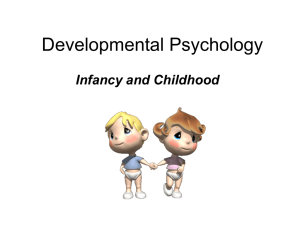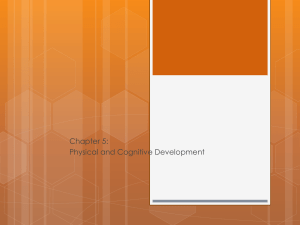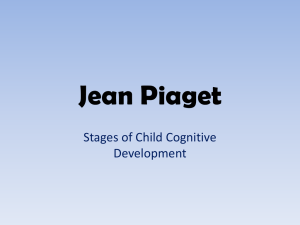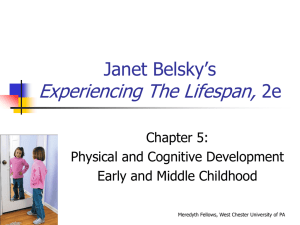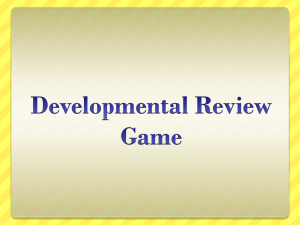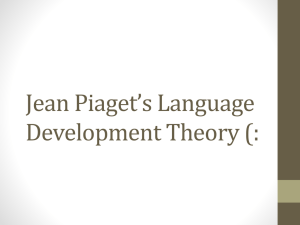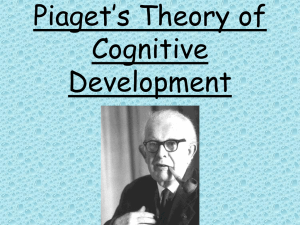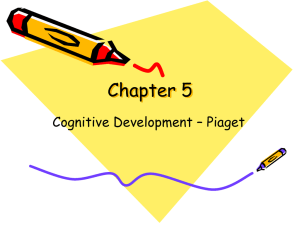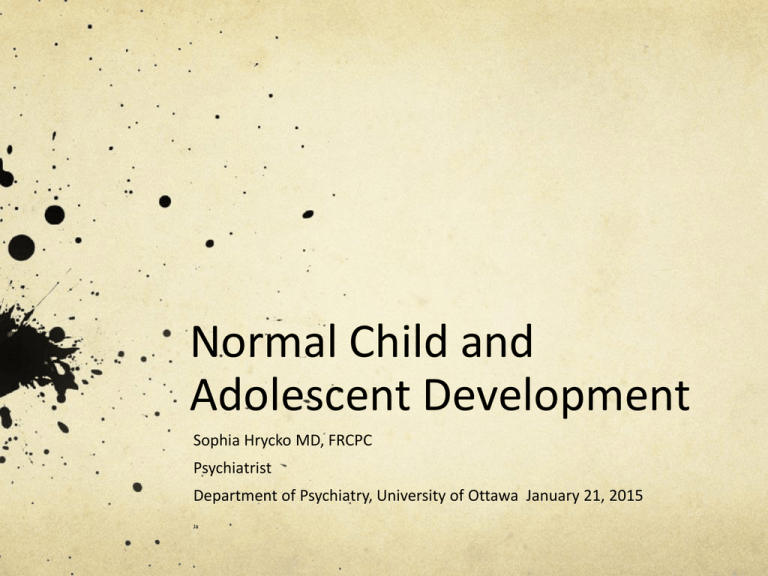
Normal Child and
Adolescent Development
Sophia Hrycko MD, FRCPC
Psychiatrist
Department of Psychiatry, University of Ottawa January 21, 2015
Ja
Disclosure
You may only access and use this PowerPoint
presentation for educational purposes. You may
not post this presentation online or distribute it
without the permission of the author.
Conflict of Interest
None
Why study normal
development?
Need to know what is normal to be able to diagnose
pathology.
How to “use” these slides: Some topics are discussed to
help you understand key concepts (Work of Ainsworth,
Thomas and Chess, etc.) you don’t need to “memorize
this”! I will tell you which slides are “key”. (slides with * =
supplemental information)
The objectives DON’T include pathology/disorders. I may
mention some disorders to help you understand why and
how , in the practice of medicine, understanding child
development is important.
Objectives
Describe the normal development of children from
infancy to adolescence (5273)
Explain the major theories of development including
the work of Sigmund Freud, Erik Erikson and Jean
Piaget (5274)
Describe the theory of attachment described by
Bowlby (5277 )
Game plan
Present normal development chronologically i.e.
infancy, pre-school, latency/school age, and
adolescence
Will discuss in infancy the concepts of major
developmental theories which will be reviewed for
specific stage of development
Will have short video after each stage of
development and 2 video at the end on attachment,
emotions
Child Development
“normative” child
Development is a dynamic process
Nature (genes) interacts with nurture
(environment) continually
Complex process (impact of risk/protective
factors)
Developmental Phases
(Erickson)
Infancy
Birth to 24 months, Basic Trust: I trust my parents and others
Pre-school
2 to 5 (6) years, Autonomy: I like to explore, but sometimes I
get afraid when I can’t see my mom or dad.
School-age/latency
6 years-12 years, Industry: I like to show my friends what I can
do.
Adolescence
12 years to 19 (24) years, Identity: I know who I am, and I’m
not exactly like my parents.
Infancy (0 – 2y)
Prenatal Variables
Perinatal Variables
Physical abilities
Cognitive abilities
Temperament
Emotions (Erikson: Basic Trust vs Mistrust, Autonomy
vs Shame and Doubt)
Infancy 0 – 2y
Motor skills
4 wks: tonic neck reflex
16 wks: rolls to prone, hands engage in midline
28 wks: sits unsupported
40 wks: pulls to stand, cruises
52 wks: picks up objects, walks several steps
15 mo: walks alone
Adaptive skills
4 wks: responds to sounds, follow moving object to midline
16 wks: looks at object in hand
28 wks: one hand reach and grasp of toy, transfer toy
52 wks: releases toy, imitates scribble
Infancy
Language skills
8 wks: vocalized in response to social stimulation;
16 wks: laughs and squeals, “talks to people”;
40 wks: “mama, “dada”, responds to “no-no”;
15 mo: 10 -19 words, knows body part
Social skills
4 wks: regards face;
8 wks: follows moving person, smiles responsively;
16 wks: initiates social smiles;
40 wks: initiates “peek-a-boo”;
52 wks: points for wants
Attachment (Bowlby)
Attachment is primary drive for survival (evolutionary
advantage).
It is an emotional relationship (connection) with
mutual affection, desire to maintain proximity.
Specific to the person.
Sensitive period in the first 3 years
Attachment behaviors promote proximity to caregiver
(crying, following, smiling, clinging).
Bowlby’s theory of Attachment*
Pre-attachment:
0 to 12 weeks
Attachment making:
12 weeks – 6 mo. With appropriate care giving, infants are able
to prefer one particular person and begin attachment making
phase
Clear cut attachment:
6 mo – 2 y. Has learned trust, people can be counted on to be
there
Reciprocal relationship:
2 y on. Reciprocity: people take turns interacting. Effectance:
their behavior produces some kind of result in the parenting
person. Partnership, internal working models
Mary Ainsworth*
Expanded on Bowlby’s observations.
Confirmed that attachment serves the purpose to decrease
anxiety.
1954-1955: for 9 months, observed 28 children aged 1 to 24
mo.
Secure attachment N = 16
Child cries little, happy to be with mother, can explore environment in
mother’s presence
Insecure attachment N = 7
Cry often, even in mother’s arms, little exploration of environment
Avoidant attachment N = 5
Not yet attached, respond the same to mother and other adults
M. Ainsworth Strange
Situation*
For child 12 mo with mother observed in the lab.
Note the reaction of the child over 8 episodes of
3 min. involving separation and reunion between
mother and child, introduction of a stranger.
B. Secure attachment 65% (best)
A. Insecure avoidant 21%
C. Insecure ambivalent 14% (“cranky”)
D. Insecure-Disorganized (5% but 80% of abused
children) Main & Solomon 1990
Temperament Development*
Definition: “an individual’s character, disposition,
and tendencies as revealed in his reactions.” Collins
Dict.
Affective tone, responsivity, motivation, “personality”
Chess and Thomas conceptualized temperament as
representing the HOW, or style of behavior, as
contrasted to the WHY, or motivations and goals of
behavior, and the WHAT, or perceptions abilities, and
talents of the individual.
Temperamental Attributes*
Temperamental Constellations*
Easy Temperament 40%
Biological regularity, approach tendencies to the new, quick
adaptability to change, a predominantly positive mood of mild or
moderate intensity
Difficult Temperament 10%
Biological irregularity, withdrawal tendencies to the new, slow
adaptability to change, frequent negative emotional expressions of
high intensity
Slow to warm up temperament 15%
Withdrawal tendencies to the new, slow adaptability to change,
frequent negative emotional reaction of low intensity, “shy”
Other 35%
Goodness of Fit
The compatibility of traits between children and
their parents = Goodness of fit
Good fit: results in parents behaving with more
sensitivity and positive interactions with their
children
Therapy: work to improve fit
Developmental Theories
Psychoanalytical: Sigmund Freud
Cognitive development: Jean Piaget
Social development: Erik Erikson
Psychoanalytical (Freud)
Psychoanalytical (the sexual aim of young infant is to obtain
pleasure and relief from discomfort by the most immediate
means possible. The infant draws pleasure from visual, tactile,
kinesthetic and auditory stimuli). (conscious and unconscious
emotions and defense mechanisms can contribute to the
development of negative emotional/cognitive states)
Stages:
Oral phase (birth – 18 mo) (Infancy)
Anal phase (12 – 18 mo – 3 y) (Toddlerhood)
Phallic-Oedipal phase (3 – 5 y) (Pre-school)
Latency phase (5 – 6 – 11 y) (School-age)
Adolescent Genital Phase (11 – 12 y on)
Psychoanalytical (Freud)
Oral Stage: mouth, most sensitive and greatest source of pleasure.
Mouthing, sucking and biting.
Anal Stage:. Control, Action, controllable pleasure.
Phallic-Oedipal Phase: Child is aware of anatomical differences
between sexes, experience of intense sexual and aggressive urges
toward both parents. Understanding of the relationship between
parents, a wish to remain the center of their lives, while realizing the
gender/sexual roles of the same sex-parent.
Oedipus complex: the child’s desire for intimacy with the opposite
sex parent. Resolution: identify with same-sex parent while
retaining affection of opposite-sex parent. Consolidation of gender
identity formation.
Psychoanalytical (Freud)
Latency Stage: relative quiescence of libidinal
drives. Sexual drives are channeled into
socially appropriate activities (school, sports).
Development of ego, superego.
Adolescent Genital Stage: Final stage of
psychosexual development, separation from
family, identity formation and psychological
capacity for true intimacy
Cognitive Development
(Piaget)*
A child needs to find ways to understand, to remember,
to solve problems, and to organize their environment.
“making and using knowledge”: includes attention,
information processing, thinking, intuition, memory, etc.
Constructivism, stage-based theory
The child is a scientist trying to develop mature scientific
thought processes
Explains cognitive maturation by use of a biological model that
focuses upon schemes (i.e. organized ways for children’s
developing brains to make sense of their experiences or
internalized frame of reference)
No focus on social and emotional development
Cognitive Development
(Piaget)*
To structure such schemes, children use 2
complementary processes:
Assimilation: integration of external element (take new
experience into existing schema)
Accommodation: modify existing schema to adapt to new
experience
Equilibrium (balance) = creation of new knowledge
Cognitive growth occurs in structural stages
Cognitive maturity is defined by a child’s increasingly
refined ability to conceptualize space, both internally
and externally.
Piaget’s 4 Periods of Cognitive
Development
Sensorimotor stage (birth – 2 y)
•
Infant use body senses and activity to explore their
environment.
- Reflexive, presymbolic:
- imitation, smiles, playful
- looks for objects partially hidden (interactions with
the external world)
- peek-a-boo, finds hidden objects (complex
intentional behavior)
- explores properties and drops objects
Sensorymotor (1 – 2y)
18 mo – 2 y: mental representation, make
believe play, memory of objects
Object permanence: i.e. the ability to
remember an object once it is out of sight (12
– 18 mo) (can manipulate images, words
internally)
Age
Sigmund Freud
Jean Piaget
Erik Erickson
Infancy 0-2y
Oral stage
(mouth:
frustration/gratifi
cation)
Anal stage (1-3y):
toilet training
Sensory motor
stage: reflexes,
uses senses to
interact with
environment,
motor activities
Object
permanence
Onset language
Basic Trust:
weaning,
separation from
parent, need to
trust and feel
loved by
caregivers
Autonomy vs
Shame/Doubt (13y): toilet
training,
independence,
need to be
supported by
parent, need to
be able to try
things without
fear of being
punished/judged
if fails
Video
2 weeks, primitive reflexes (#6)
Primitive reflexes shown in this clip: toe grasp, clonus,
tone, incurvation, crawling, walking, weight-bearing. Note
head control. – Some reflexes extinguish with
development (only returning in pathological states), others
persist.
Video boy 11.5 mo and girl 10.5 mo (#7)
Social communication, aggression, frustration,
competition, negotiation, conflict resolution btwn infants
Video Ainsworth strange situation (#10)
Social Development – Attachment Theory*
4 phases in the social maturation process:
Period of attachment, child develop a
sense of self
Period of self-understanding: allows
children to analyze their own make up
Period of perspective taking: child apply
self-knowledge to adults and peers
Period of true friendship and peer
orientation
Social Development Erik Erikson
Basic Trust vs Mistrust (0 – 1 y)
Autonomy vs Shame/Doubt (1 – 3 y)
Initiative vs Guilt (3 – 5 y)
Industry vs Inferiority (6 – 11 y)
Identity vs Role Confusion (11 – 20 y)
Intimacy vs Isolation (21 – 40 y)
Generativity vs Stagnation (40 – 65 y)
Integrity vs Despair (65+)
Pre-school (2 – 5 y)
Tasks:
Autonomous identity: separate individuals who can be
autonomous despite wish to be dependent at times on
parents/others
Gender identity: I am a boy/girl.
Role of Environment:
Protect child in his assertive explorations from experiencing
too many episodes of over/under-stimulation.
Teach child to gratify his needs/wishes within the family/social
environment while respecting limits/rules of parents.
Provide emphatically attuned encouragements
support/admiration for growing autonomy while teaching that
autonomy has limits/restrictions.
Preschool
Physical development:
Can walk, run, control of sphincters (21/2 for day urination,
night: 4 y, bowel: 4 y) Sleep: 12 h (naps)
Cognitive development:
Sense of themselves as separate
Can appreciate right, wrong, good, bad, valued/not valued.
Can infer the emotional state of another person, they usually
project their own feelings onto others and they identify with
the projected feelings.
Use verbal language to identify actions.
Ability to understand concepts expressed in verbal language:
can store explicit memories (information encoded in verbal
form)
Preschool
Cognitive Development:
Ability to form fantasies
Ability to form beliefs: a conception that establishes the
relationship between 2 or more inanimate objects, aspects
of nature’s law or people. The sun makes the earth warm,
the earth moves.
Ability to form categories.
Ability to use primary (magical, absence of logical
connections) and secondary process (reality based, logical)
thinking.
Cannot understand conservation (pie cut in 4 and 8 pieces
not equal, want the one cut in 8)
Preschool
Play: primary means by which children teach
themselves.
Pretend games, imaginary friend common
Function of play:
Act out playful fantasy, a pleasurable life experience
using toys, other adults, children as symbols for the
real experience, acquiring new knowledge in the
process.
To practice delaying the behavioral or verbal
expression of skills and feelings that are causing
developmental conflicts with parents.
To unconsciously attempt to reconstruct a pathogenic
belief, especially one resulting from a traumatic
experience
Preschool
Child has an autonomous and valued identity
Child has a gender identity as male or female
Child speaks in sentences, thinking is egocentric,
empathy is not present
Preoperational phase: begins to think symbolically
Emotional and Social Development:
Erikson: autonomy vs shame/doubt; initiative vs guilt
Freud: anal stage of development; phallic/Oedipal stage
Gender identity
Piaget Preoperational Phase (2 – 7 y)
Children become intuitive, anticipating experiences with
consequences.
Think symbolically but illogically
Concepts*:
Egocentric, unable to perceive self from others in their
environment.
Animistic “I’m afraid of the moon”
Lack of hierarchy “where do these blocks go”
Centration “I want it now, not after dinner”
Irreversibility: “I don’t know how to go back to that room”
Transductive reasoning “We have to go this way because that’s
the way Daddy goes”
Preschool
Theory of mind or mentalisation: Child has an
awareness that others have internal states and
mental representations. (decentering,
perspective taking: children become aware that
2 children looking at the same display from
different side of a table will see two different
view of the display. Later they can incorporate
thoughts and feelings of others as different from
their own).
Age
Sigmund Freud
Jean Piaget
Erik Erickson
Preschool 2 –
6y
Phallic stage:
Oedipal
complex
Preoperational
phase: Think
symbolically,
egocentric,
magical
thinking
Initiative vs
guilt: imitate
adults, do things
independently,
has goals
Video age 3y 8mo (# 18)
Pretends to be a pink elephant animal (special blanket),
fantasy vs reality, transitional object
Video age 2 1/2y (#106)
Ability to role play, and relive daily events by creating
small reenactments.
– Some gender role rehearsing is involved (she is
pretending to be Mommy, not Daddy).
– Use of 2nd person pronouns.
Video age 4y 2mo (#132)
Piaget: conservation of length; knows categories but lacks
flexibility to shift concepts. Pre-operational thought
School-age (6 – 12 y)
Language and cognitive development
Can express complex ideas
Logic is very important
Piaget: concrete operations: conceptual
skills develop and thinking become
organized and logical.
Improved gross motor development:
sports, arts
School-age
Emotional and social behavior
Freud: latency period. Superego
development
Moral development starts
Identification with other adults
Idealize same parent
Peer interactions are more important
Empathy starts
Erikson: Industry versus Inferiority
Piaget: Concrete Operational Stage
Ability to think logically, in an organized
fashion
Concepts*:
Hierarchical classifications: arranges cars by types
Reversibility: can play games backward and
forward
Conservation: lose 2 dimes can look for same
Decentration: worry about small details,
obsessive
Spatial operations: likes models for directions
Age
Sigmund Freud
Jean Piaget
Erik Erickson
Latency/school
age 6-12y
Latency, ego
and superego
development
Concrete
operational
phase: ongoing
learning and
consolidation
of knowledge:
thinks logically.
Concepts;
classification
(hierarchy),
reversibility,
conservation,
decentration
Industry vs
inferiority.
Task: going to
school, doing
things and
creation to
discover
interests
talents, learn
their
strengths,.
Competence
Video age 6y 8 mo (# 23)
“don’t hope for things : they will come true, and vice-versa”. God (or
her conscience) punishes her for disobeying her father, by causing a
flat tire.
Magical thinking, egocentricity, religion, moral development,
development of conscience
Trying to make sense of the world, searching for cause and effect.
Video 11 y (#32)
Time management will be a crucial life skill, affecting his future
success in academics, his career, and his ability to juggle work
and home life. This is a good time to learn how to prioritize,
plan, and not leave things to the last minute.
–Rather than not allowing Brian to go to the pick-up game,
Mom lets Brian make his own decisions, then encourages him
to learn from his experience and change future choices
accordingly.
–Effort is highly dependent on the degree to which one is
inspired by the task at hand (soccer versus clarinet, for
example). Mom never had to remind Brian to get ready to go
to his soccer games, or push him to practice his athletic skills.
Adolescence (12 – 19y)
Profound biological, social and psychological
changes
Biological: rapid acceleration of skeletal growth;
physical sexual development
Psychological: acceleration of cognitive
development; consolidation of personality
formation; thinking becomes abstract,
conceptual, future oriented
Social: preparation for role of young adult;
development of morals (conformity to shared
standards, rights and duties)
Variable: age of onset, length, rate of growth etc.
Rite of passage
Adolescent turmoil is NOT common, NOT normal
About 20% of adolescents will have a diagnosable
mental disorder: Adjustment disorder, anxiety
disorder, depressive disorder.
Piaget: Formal Operational (11 +)
Concepts:
Hypothetic-deductive reasoning
Imaginary audience, everyone is looking at them
Personal fable: inflated opinion of themselves
Propositional thinking, logic
Capacity to think abstractly (can think about thoughts)
Adolescence
Development of identity, sense of self (self-concept, selfimage) is more negative and less stable early than later
adolescence
Social Development: expansion of relationships beyond
the family: peer group; shift from parents to peers as
providers of companionship, intimacy; need peer approval
and advice; development of empathy
Risk taking: 40% of all teenage death due to MVA. 2000
survey: 40% of HS students used THC, 85% alcohol (32%
binge drinking), 3% cigarettes
Adolescence
Pressures:
to succeed academically
to make vocational choices early
Autonomy from family
Accept growing/changing body
Age
Sigmund Freud
Jean Piaget
Erik Erickson
Adolescence
12 – 24y
Genital stage:
ability to have
intimate
relationships
Formal
operational
phase.
Concept:
hypotheticdeductive
reasoning,
logic, capacity
to think
abstractly,
Identity vs role
confusion.
Task: social
identity, need
to define and
clarify personal
and
professional
interests.
Importance of
appearance,
role models,
belonging to a
group
Strength:
Fidelity
Video age 13.5 (#8)
Cheated on an exam.
Morality, parental expectation, observation of peers
behavior (tolerating it)
Question 1
Theories of development formulated by Freud, Erikson, and
Piaget share which of the following characteristics?
A. They postulate a genetically determined capacity for the
development of patterns or systems of behavior by the child.
B. They propose that the overall behavior patterns that emerge are
qualitatively similar to one another.
C. They are all structural theories of development that imply that
reorganizations within the child is unnecessary.
D. They postulate that the child reacts in particular ways to
environmental stimuli.
E. None of the above.
Question 1
Theories of development formulated by Freud, Erikson, and
Piaget share which of the following characteristics?
A. They postulate a genetically determined capacity for the
development of patterns or systems of behavior by the child.
B. They propose that the overall behavior patterns that emerge are
qualitatively similar to one another.
C. They are all structural theories of development that imply that
reorganizations within the child is unnecessary.
D. They postulate that the child reacts in particular ways to
environmental stimuli.
E. None of the above.
Question 2
By age 5 years, a child will have attained all of
the following motor developmental
milestones except:
A. Can stand on one foot.
B. Can dance and jump.
C. Manifests firmly established legs, eye and ear
dominance.
D. Can copy a square.
E. Can build a tower of 10 cubes.
Question 2
By age 5 years, a child will have attained all of
the following motor developmental
milestones except:
A. Can stand on one foot.
B. Can dance and jump.
C. Manifests firmly established legs, eye and ear
dominance. (starts age 2-3, well developed age 5)
D. Can copy a square.
E. Can build a tower of 10 cubes.
Dominance: foot: 7y, eye 8y, ear 9y
Question 3
Piaget conceptualized 4 major stages of cognitive
development. Which of the following states the correct
sequence in which these stages normally occur, from
birth to adolescence?
A. Preoperational, sensorimotor, concrete operational, formal
operational.
B. Concrete operational, sensorimotor, preoperational, formal
operational.
C. Sensorimotor, concrete operational, formal porational,
preoperational.
D. Formal operational, concrete operational, sensorimotor,
preoperational.
E. Sensorimotor, preoperational, concrete operational, formal
operational.
Question 3
Piaget conceptualized 4 major stages of cognitive
development. Which of the following states the correct
sequence in which these stages normally occur, from
birth to adolescence?
A. Preoperational, sensorimotor, concrete operational, formal
operational.
B. Concrete operational, sensorimotor, preoperational, formal
operational.
C. Sensorimotor, concrete operational, formal porational,
preoperational.
D. Formal operational, concrete operational, sensorimotor,
preoperational.
E. Sensorimotor, preoperational, concrete operational, formal
operational.
Question 4
Best description of motor behavior in a 1 y old child:
A.
B.
C.
D.
E.
Sits steadily on the floor
Pulls self to standing
Walks with one hand held
Runs
Rides a tricycle
Question 4
Best description of motor behavior in a 1 y old child:
A.
B.
C.
D.
E.
Sits steadily on the floor
Pulls self to standing
Walks with one hand held
Runs
Rides a tricycle
Question 5
Erickson’s basic trust vs mistrust stage corresponds
to Freud’s ……. Stage:
A.
B.
C.
D.
Oral
Anal
Phallic
Latency
Question 5
Erickson’s basic trust vs mistrust stage corresponds
to Freud’s ……. Stage:
A.
B.
C.
D.
Oral
Anal
Phallic
Latency
Question 6
Development task
Social smile
Reach for/grasp toy
Stand out without support
Rides a tricycle
Say 2-3 words
Pick up a small object with thumb/index
Age
Question 6
Development task
Social smile
Reach for/grasp toy
Stand out without support
Age
2 mo (4-8 wks)
6 mo
9- 10 mo
Rides a tricycle
3y
Say 2-3 words
1y
Pick up a small object with thumb/index 10 mo
Question 7
Preschoolers struggle to deal with separation
because:
A.
Their repertoire of coping abilities is still
developing
B.
They have increased cognitive abilities
C.
They are able to reassure themselves easily
D.
They have never experienced a successful
separation
E.
They are emotionally stable
Question 7
Preschoolers struggle to deal with separation
because:
A.
Their repertoire of coping abilities is still
developing
B.
They have increased cognitive abilities
C.
They are able to reassure themselves easily
D.
They have never experienced a successful
separation
E.
They are emotionally stable
Question 8
True or False: most preschool children do not
recognize that their imaginary friends are not really
visible.
A.
True
B.
False
Question 8
True or False: most preschool children do not
recognize that their imaginary friends are not really
visible.
A.
True
B.
False
Question 9
True or False: infant assessments are not only a
measure of the child’s functional or developmental
status, but also a measure of the child’s
environment.
A.
True
B.
False
Question 9
True or False: infant assessments are not only a
measure of the child’s functional or developmental
status, but also a measure of the child’s
environment.
A.
True
B.
False
Question 10
Infant are able to respond differently to their fathers
and mothers by what age?
A.
8 months
B.
6 months
C.
4 months
D.
2 months
Question 10
Infant are able to respond differently to their fathers
and mothers by what age?
A.
8 months
B.
6 months
C.
4 months
D.
2 months
Question 11
In Psychoanalytic theory, the anal phase of
psychosexual development is characterized by
A. The child’s focus on autorerotic activities.
B. The child’s experience of intense sexual and
aggressive urges toward both parents.
C. The child’s development of concepts of
inevitability regarding birth, death, and sex
differences.
D. The child’s experience of feelings of
separateness and worth.
E. the child’s sequential development of play.
Question 11
In Psychoanalytic theory, the anal phase of
psychosexual development is characterized by
A. The child’s focus on autorerotic activities.
B. The child’s experience of intense sexual and
aggressive urges toward both parents.
C. The child’s development of concepts of
inevitability regarding birth, death, and sex
differences.
D. The child’s experience of feelings of
separateness and worth.
E. the child’s sequential development of play.
Question 12
True statements about enuresis include
A. The majority of enuretic children wet
intentionally
B. There is a correlation between enuresis and
psychological disturbance that increases with age
C. Children with enuresis are more likely to have
developmental delays than other children
D. There is no evidence for a genetic component
to enuresis
E. Children living in socially disadvantaged
environments do not have an increased incidence
of enuresis
Question 12
True statements about enuresis include
A. The majority of enuretic children wet intentionally
B. There is a correlation between enuresis and
psychological disturbance that increases with age
C. Children with enuresis are more likely to have
developmental delays than other children
D. There is no evidence for a genetic component to
enuresis
E. Children living in socially disadvantaged
environments do not have an increased incidence of
enuresis
Question 13
A two year old child will most likely be able to:
A.
B.
C.
D.
E.
Build a tower of 2 or 3 cubes
Draw a circle
Run
Copy a square
Copy a triangle
Question 13
A two year old child will most likely be able to:
A. Build a tower of 2 or 3 cubes
B. Draw a circle
C. Run
D. Copy a square
E. Copy a triangle
References
Essentials of Lewis’s Child and Adolescent Psychiatry Volkmar &
Martin, 2011
Normal Development in the First ten years of Life, Geri Fox (DVD)
Normal Development in Middle childhood and Adolescence, Geri Fox
(DVD)
Video: A simple gift: Comforting your baby (10 min) and Helping Young
children cope with Emotions (17 min ) Infant Mental Health Promotion
project, The Hospital for Sick Children, 1998
References*
http://www.nimh.nih.gov/news/media/video/giedd.s
html (Development of the Young Brain
For more than twenty years, National Institute of Mental
Health neuroscientist Dr. Jay Giedd has studied the
development of the adolescent brain. Decades of imaging
work have led to remarkable insight and a more than a
few surprises.)
Many other videos on brain development, including
adolescents.


